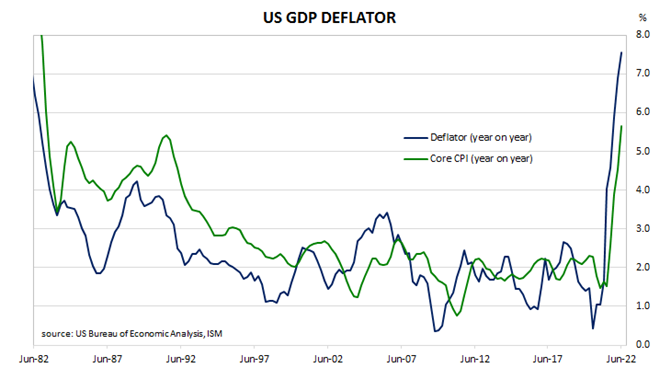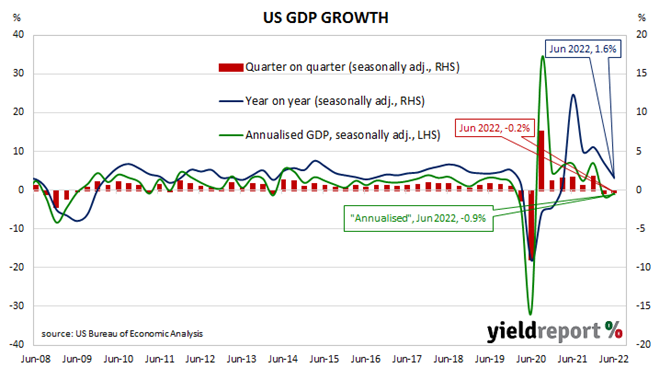Summary: US GDP down 0.2% (0.9% annualised) in June quarter; contrasts with 0.1% increase (0.5% annualised) expected; a little stronger than headline number suggests; all up a “disappointing” report; GDP price deflator annual rate rises from 6.9% to 7.5%.
US GDP growth slowed in the second quarter of 2019 before stabilising at about 0.5% per quarter. At the same time, US bond yields suggested future growth rates would be below trend. The US Fed agreed and it reduced its federal funds range three times in the second half of 2019. Pandemic restrictions in the June quarter of 2020 sent parts of the US economy into hibernation; the lifting of those same restrictions sparked a rapid recovery.
The US Bureau of Economic Analysis has now released June quarter “advance” GDP estimates and they indicate the US economy contracted by 0.2% or at an annualised rate of 0.9%. The contraction contrasted with the 0.1% increase (+0.5% annualised) which had been generally expected but it was smaller than the March quarter’s -0.2% after revisions.
“While technically a recession, the details were a little stronger than the headline number suggests,” said ANZ economist Kishti Sen. “A lot of the weakness came from inventories which subtracted 2ppts from the headline figure.”
US GDP numbers are published in a manner which is different to most other countries; quarterly figures are compounded to give an annualised figure. In countries such as Australia and the UK, an annual figure is calculated by taking the latest number and comparing it with the figure from the same period in the previous year. The diagram above shows US GDP once it has been expressed in the normal manner, as well as the annualised figure.
US Treasury bond yields dropped materially on the day. By the close of business, the 2-year Treasury bond yield had shed 16bps to 2.86%, the 10-year yield had lost 12bps to 2.67% while the 30-year yield finished 4bps lower at 3.03%.
In terms of US Fed policy, expectations for a higher federal funds rate over the next 12 months softened. At the close of business, September contracts implied an effective federal funds rate of 2.505%, 18bps higher than the current spot rate. November contracts implied 3.14% while July 2023 futures contracts implied an effective federal funds rate of 2.98%, 65bps above the spot rate.
Sen noted personal consumption had not increased as much as expected while private fixed investment had decreased by 3.9%. “All up, it was still a disappointing report, even when accounting for the outsized influence of the inventories number.”
One part of the report which is often overlooked are the figures regarding the GDP price deflator, which is another measure of inflation. The GDP price deflator is restricted to new, domestically-produced goods and services and it is not based on a fixed basket as is the case for the consumer price index (CPI). The annual rate rose from the March quarter’s revised figure of 6.9% to 7.5%.



